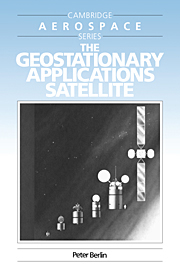Book contents
- Frontmatter
- Contents
- Dedication
- Preface
- List of Acronyms
- 1 Launch vehicles
- 2 The transfer orbit
- 3 The geostationary orbit
- 4 The satellite environment
- 5 Structures
- 6 Mechanisms
- 7 Thermal control
- 8 Power supply and conditioning
- 9 Propulsion and orbit control
- 10 Attitude stabilization, measurement and control
- 11 Telemetry, tracking and command (TT&C)
- 12 Communications payload
- 13 Meteorological payload
- 14 Product assurance
- 15 Spacecraft development and testing
- Index
- Frontmatter
- Contents
- Dedication
- Preface
- List of Acronyms
- 1 Launch vehicles
- 2 The transfer orbit
- 3 The geostationary orbit
- 4 The satellite environment
- 5 Structures
- 6 Mechanisms
- 7 Thermal control
- 8 Power supply and conditioning
- 9 Propulsion and orbit control
- 10 Attitude stabilization, measurement and control
- 11 Telemetry, tracking and command (TT&C)
- 12 Communications payload
- 13 Meteorological payload
- 14 Product assurance
- 15 Spacecraft development and testing
- Index
Summary
Twenty-two thousand miles above the equator, a very special family of man-made satelllites circles the earth. Basking in the sunshine, their wings dark blue and their bodies golden, they look like parrots perched side by side on an endless telephone wire. Most strain their ears to pick up messages from one part of the world and relay them to another. Some spend all their time observing the evolution of weather patterns in the atmosphere below. A few size up the earth to the nearest inch, while others perform scientific experiments. All of the satellites are hypochondriacal chatterboxes who mix tales about what they have just seen, heard or felt with frequent reports about their precarious health.
This is the family of geostationary satellites, so named because to an observer on the earth they appear to be fixed at one point in the sky. In fact they are not fixed at all but travel around the earth at the same rate as the earth turns about its axis. Unlike spacecraft in any other orbit, a geostationary satellite remains constantly within view of almost half the earth at all times, which is why it is so eminently suited for telecommunications and earth observation.
The spacecraft literature abounds with titles on payloads, such as telecommunication transponders, radiometers and scientific instruments. The rest of the spacecraft, called the platform, is usually only presented in outline, and the presentation of launch vehicles, orbits and programmatic issues is often schematic.
- Type
- Chapter
- Information
- The Geostationary Applications Satellite , pp. xi - xiiPublisher: Cambridge University PressPrint publication year: 1988

